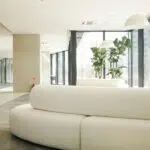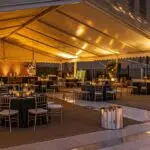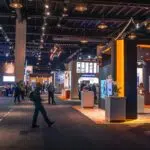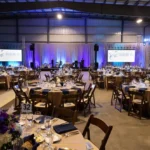Designing a dedicated networking lounge at corporate events is essential for fostering valuable connections. Event planners must create an inviting, functional space that boosts interactions while reflecting the corporate brand. This article outlines a framework for defining objectives, optimizing layouts, selecting furniture and decor, integrating technology, curating engaging experiences, and assessing success. By following these guidelines, companies can increase bookings and generate valuable leads.
Key Takeaways
- Clear objectives align the lounge with overall event goals.
- Strategic layout design with zoning and thoughtful furniture enhances conversation.
- Integrated technology and curated experiences improve engagement.
- Regular feedback and performance assessments support continuous improvements.
Defining Objectives for Your Corporate Event Networking Lounge
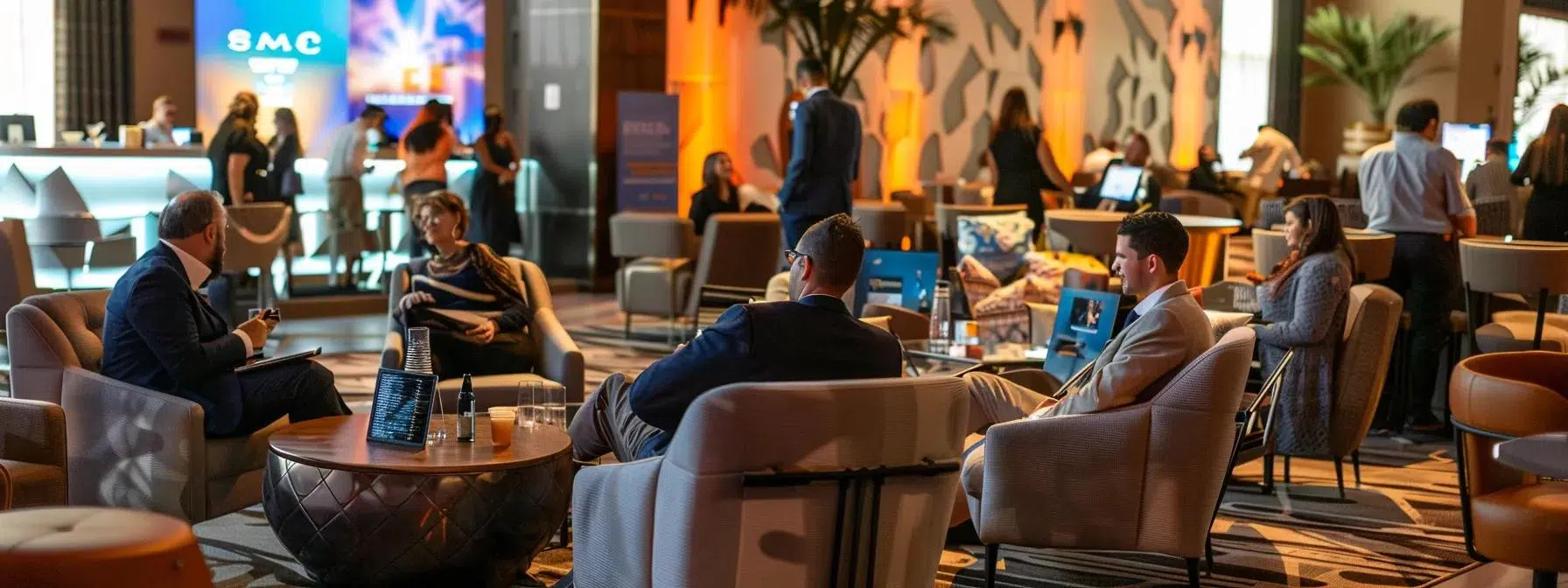
Start by setting precise objectives that align the lounge with the event’s purpose. Focus on encouraging high-value interactions among targeted attendee groups, increasing lead generation, and boosting the event experience. Define desired interactions—whether informal chats or strategic business discussions—and set measurable outcomes (e.g., new contacts made or leads captured). Understanding attendee expectations will help design a space that supports effective connection building through appropriate seating, decor, and layout choices.
Aligning Lounge Goals With Overall Event Aims
Ensure the lounge extends the event’s vision. It should reflect the event’s themes and encourage interactions that support those themes. Consistent messaging, signage, and coordinated activities help connect the main event with the networking area.
Identifying Target Attendee Interactions for the Networking Space
Tailor the space by understanding the audience’s networking behavior. Whether targeting industry experts, potential clients, or new partners, identify the specific interactions desired. This clarity assists in customizing the layout, decor, and amenities for casual meet-and-greets or formal discussions.
Setting Measurable Outcomes for Your Networking Lounge for Corporate Events
Define clear success metrics such as the number of connections, lead capture rates, or satisfaction survey scores. These benchmarks allow organizers to make data-driven improvements. For example, if the target is 50 qualified leads, the design should encourage visitors to register their details easily.
Establishing the Desired Atmosphere for Connection Building
A well-crafted ambiance stimulates conversation. The lounge should combine modern aesthetics with warm, welcoming elements. Light music, subtle lighting, and soothing decor work together to create a relaxed setting ideal for networking.
Designing the Optimal Layout for a Networking Lounge at Corporate Events
An effective layout ensures smooth traffic flow and supports a variety of interactions. Integrate designated zones that cater to both spontaneous encounters and planned discussions. A thoughtful layout not only enhances the attendee experience but also encourages valuable conversations.
Choosing a Strategic Location for Maximum Attendee Flow
Select a location that is both high-traffic and suitably secluded for in-depth conversations. Being near registration areas or main halls naturally draws attendees while ensuring privacy for networking. Easy entry and exit are essential to maintain a smooth flow.
Zoning the Space for Different Types of Interactions
Divide the lounge into zones for informal chats, private meetings, and collaborative sessions. This ensures that every networking style is accommodated, from quick exchanges of business cards to more focused discussions in quieter settings.
Ensuring Comfortable Traffic Patterns Within the Lounge Area
To foster easy navigation, plan clear pathways and avoid overcrowding. Well-marked routes reduce bottlenecks and assist attendees in effortlessly moving between zones, minimizing stress and enhancing engagement.
Incorporating Branding Elements Subtly in the Design
Integrate branding in a subtle yet effective manner. Use company logos, color schemes, and custom decor to echo the corporate identity without overshadowing the networking purpose. Branded textiles and digital displays can reinforce the brand while keeping the focus on conversations.
Planning for Accessibility in Your Networking Lounge Design
Accessibility is key for inclusivity. Design the lounge with unobstructed pathways, ramps where needed, and easy-to-access furniture. Making the space welcoming for all attendees improves overall satisfaction and engagement.
Selecting Furniture and Decor to Foster Networking Opportunities

The right furnishings create a comfortable, functional, and inviting environment. Thoughtful seating, effective lighting, and well-chosen decor support prolonged usage and help reinforce the event’s branding.
Choosing Comfortable Seating Arrangements for Conversations
Comfortable seating is crucial. Use ergonomic chairs, sofas, and modular options that encourage both group discussions and one-on-one meetings. Ensure that seating is arranged to promote clear sightlines and easy conversation.
Utilizing Lighting to Create an Inviting Ambiance
Lighting sets the tone. Combining ambient and accent lighting enhances the mood and highlights important areas, such as conversation zones and digital displays, guiding attendees subtly through the space.
Integrating Natural Elements or Greenery for a Relaxing Feel
Incorporate natural elements like potted plants or living walls to add a refreshing touch. These features help balance the corporate environment and reduce stress, fostering more engaging interactions.
Selecting Decor That Reflects Your Corporate Identity
Choose decor that mirrors the company’s colors and values. The decor should be visually appealing and provide practical benefits, reinforcing a cohesive brand image throughout the event.
Arranging Furniture to Encourage Small Group Formations
Strategically position furniture to create intimate settings that encourage small group discussions. Grouping seating in semi-private clusters maximizes space and facilitates spontaneous networking.
Integrating Technology to Support Your Networking Lounge for Corporate Events
Modern technology enhances how attendees connect. Integrate elements like charging stations, Wi-Fi, digital displays, and interactive tools to boost convenience and engagement.
Providing Charging Stations for Attendee Convenience
Ensure that charging stations are readily available. They keep devices powered, allowing attendees to stay connected and engage longer during the event.
Offering Wi-Fi Access Within the Networking Area
High-speed Wi-Fi is essential. Reliable internet access supports on-the-spot networking, online profile access, and smooth digital interactions.
Using Digital Displays for Information or Sponsor Recognition
Digital screens can display real-time event updates, sponsor messages, and interactive content. These displays add a modern element while keeping attendees informed and engaged.
Exploring Interactive Tech for Engagement in the Lounge Space
Incorporate interactive technologies like touchscreens and QR code stations. These tools simplify networking by allowing visitors to share information effortlessly and transition from casual chats to concrete business connections.
Considering Lead Capture Tools for Exhibitors if Applicable
Integrate lead capture solutions that let exhibitors collect attendee contact data easily. Digital sign-up forms or interactive kiosks can improve follow-up efficiency and result in a measurable return on investment.
Curating Engaging Experiences Within the Corporate Event Networking Space
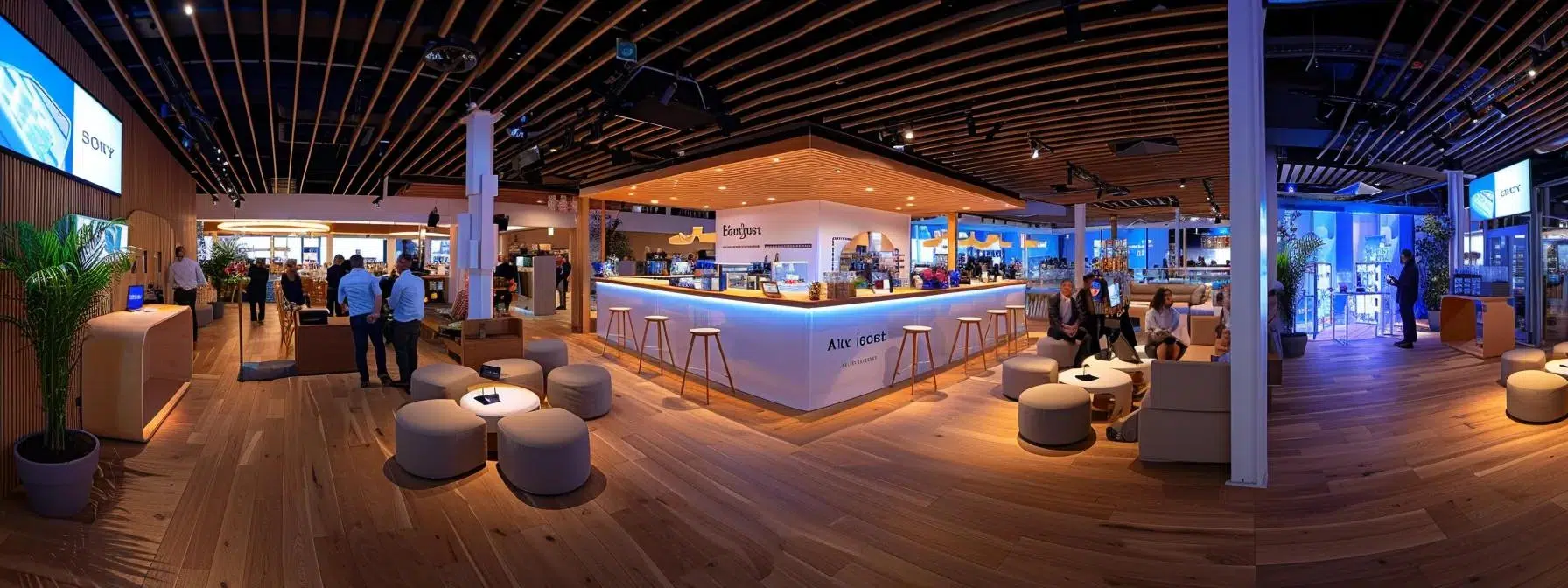
Beyond design, the overall experience plays a major role. Curate light refreshments, background music, and themed conversation starters to create an inviting atmosphere that encourages networking.
Arranging Light Refreshments and Beverage Options
Offer light refreshments to create a hospitable setting. Well-designed snack bars serve as natural meeting points where attendees can relax and initiate conversations.
Introducing Low-Key Entertainment or Background Music
Subtle background music can enhance the ambiance without overpowering conversations. Live acoustic performances or digital art displays add a lively yet unobtrusive touch.
Facilitating Themed Conversation Starters or Icebreakers
Use conversation starters or icebreakers to lower initial barriers. These activities can help break the ice, making it easier for attendees to find common ground and engage meaningfully.
Designating Areas for Specific Interest Group Meetups
Create dedicated zones for different interest groups, such as a tech corner or startup hub. These targeted areas enable like-minded individuals to network more effectively.
Incorporating Interactive Elements or Games
Interactive elements and games can lighten the formal atmosphere and encourage spontaneous networking. Whether through digital scavenger hunts or group challenges, these features promote team building and memorable interactions.
Assessing the Success of Your Networking Lounge Initiative

Regular assessment is vital to measure the lounge’s impact and identify improvements. Use a combination of feedback, direct observations, and social media monitoring to refine the networking experience continuously.
Gathering Attendee Feedback on the Lounge Experience
Collect feedback through surveys or digital forms. Honest, constructive responses provide key insights into what is working well and what could be improved in the lounge design.
Observing Usage Patterns and Popular Zones
Monitor attendee movements and interactions. Tracking which zones are most popular helps determine if the design is effectively promoting networking and where adjustments might be needed.
Tracking Connections Made or Leads Generated if Possible
Where possible, use digital tools to track the number of connections and leads generated. These metrics are useful for demonstrating the lounge’s return on investment.
Reviewing Social Media Mentions Related to the Networking Area
Analyze social media activity to gauge attendee sentiment and engagement. Hashtags, check-ins, and posts provide additional insights into how the lounge is perceived publicly.
Identifying Areas for Improvement for Future Corporate Event Lounges
Use all gathered data to pinpoint specific design elements that need improvement. Continuous, data-driven adjustments ensure the lounge remains effective as attendee expectations and technologies evolve.
Table: Comparing Key Features of a Successful Networking Lounge
Before final thoughts, consider this summary table:
| Feature | Key Attribute | Benefit | Performance Metric |
|---|---|---|---|
| Strategic Location | High visibility & accessibility | Maximizes attendee flow and engagement | Increased foot traffic by 25% |
| Zoning for Interactions | Multiple dedicated zones | Tailors experience to varied needs | 30% longer dwell time |
| Integrated Technology | High-speed Wi-Fi, digital displays | Enhances connectivity and live updates | 40% higher lead capture |
| Comfortable Seatings & Decor | Ergonomic furniture, branded decor | Facilitates relaxed conversations | 20% improvement in satisfaction |
Final Thoughts
Designing a premium networking lounge for corporate events requires focused planning and creative design. From setting clear objectives and choosing optimal layouts to incorporating modern technology and curating engaging experiences, every element is key to fostering connections. Regular feedback and data-driven insights ensure continuous improvement. With these strategies, the networking lounge can become an epicenter for innovation and collaboration, driving both higher leads and business success.
Frequently Asked Questions
Q: How do clear objectives impact networking lounge design?
A: Clear objectives align every element with event goals, ensuring targeted interactions and measurable outcomes.
Q: Why is seating arrangement critical in a networking area?
A: Comfortable seating promotes relaxed conversations and supports both casual and structured discussions.
Q: How can technology enhance a corporate networking lounge?
A: Technologies such as high-speed Wi-Fi, charging stations, and digital displays improve connectivity and streamline interactions.
Q: What role does feedback play in improving the lounge experience?
A: Attendee feedback provides actionable insights, allowing planners to refine layouts, amenities, and overall engagement.
Q: How can event planners measure networking success?
A: Success is measured using lead capture metrics, attendee surveys, and social media engagement data to guide future improvements.

